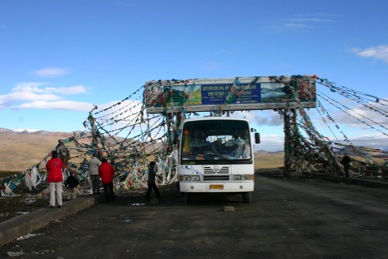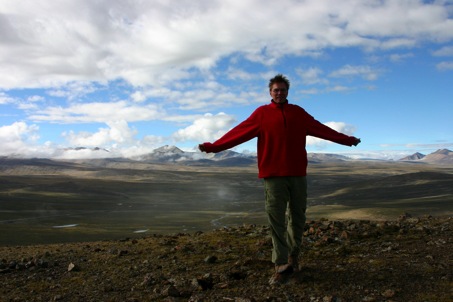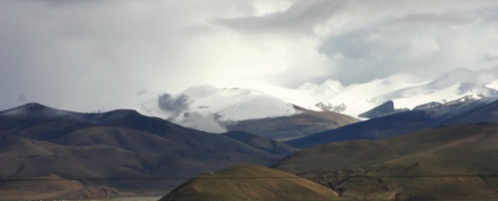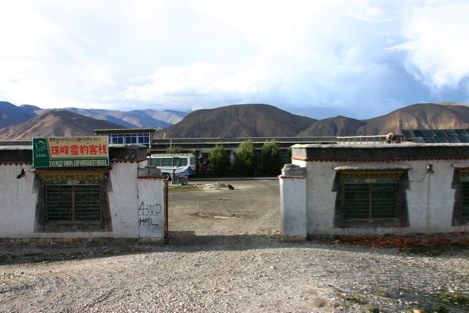


Tinggri

 Sunday 3 September – Tinggri
Sunday 3 September – Tinggri A very long travel day. The trend since Shigatse has been increasing altitude and more barren landscape, and this continuous as we travel more and more towards the West. Soon after our departure we climb up a pass which is going to be the highest on the trip –the Gyatso-la at 5220 m. Unlike earlier passes with many switchbacks, the road just gradually climbs for a long time, until an arch with prayer flags  indicates the highest point. Because the view is only average, some decide (under the leadership of Thea, one of the older people in the group, but with surprising mountain-goat genes) to climb to closest hill. Very cold, and we pant like dogs! Still no great view, but at least some deed has been done. Soon afterwards, the asphalt road turns into a dirt road, occasionally interrupted by roadwork. This roadwork sometimes means waiting, or at other times making a large detour over even smaller and bumpier dirt roads.
indicates the highest point. Because the view is only average, some decide (under the leadership of Thea, one of the older people in the group, but with surprising mountain-goat genes) to climb to closest hill. Very cold, and we pant like dogs! Still no great view, but at least some deed has been done. Soon afterwards, the asphalt road turns into a dirt road, occasionally interrupted by roadwork. This roadwork sometimes means waiting, or at other times making a large detour over even smaller and bumpier dirt roads.
 indicates the highest point. Because the view is only average, some decide (under the leadership of Thea, one of the older people in the group, but with surprising mountain-goat genes) to climb to closest hill. Very cold, and we pant like dogs! Still no great view, but at least some deed has been done. Soon afterwards, the asphalt road turns into a dirt road, occasionally interrupted by roadwork. This roadwork sometimes means waiting, or at other times making a large detour over even smaller and bumpier dirt roads.
indicates the highest point. Because the view is only average, some decide (under the leadership of Thea, one of the older people in the group, but with surprising mountain-goat genes) to climb to closest hill. Very cold, and we pant like dogs! Still no great view, but at least some deed has been done. Soon afterwards, the asphalt road turns into a dirt road, occasionally interrupted by roadwork. This roadwork sometimes means waiting, or at other times making a large detour over even smaller and bumpier dirt roads. The route description promised possible views on Everest during the trip and in Tinggri itself, but unfortunately the mountain is in the clouds and doesn’t show itself. In Tinggri we do get a good view on the Cho Ogu, with 8153 m also a Himalaya giant.
The route description promised possible views on Everest during the trip and in Tinggri itself, but unfortunately the mountain is in the clouds and doesn’t show itself. In Tinggri we do get a good view on the Cho Ogu, with 8153 m also a Himalaya giant.The guesthouse in Tinggri is even more basic than in Lhatse, and it is cold and windy. In the village itself it is hard to buy anything, because shops have few items and are obscured by dust clouds, but we manage to secure ourselves some water, bananas, and cookies. (The cookies, fake Oreos, turned out to taste like nothing, even though they boasted “Egg Yolk!!”)
Who needs places like Tinggri? So, if you come from Nepal, Tinggri is usually your first stop if you plan on hiking/biking/crawling to the “Everest Base Camp.” For us, it was our last stop in Tibet. Unfortunately. A dismal heap of dusty shops, barking dogs, and trash (in which the dogs blissfully grovel) penetrated by a mean “desert wind,” Tinggri left me cold, literally.
 Our “guesthouse” was a smelly dump called “Snow Leopard Guesthouse,” a rectangular complex of motel-style parterre slots, which, to our joy, was being expanded with more of the same. Despite the moldy pillows and the mortar raining from the cracked ceilings, the place had its saving graces. A cheerful restaurant with a hot stove in the middle of the room and the typical Tibetan “couch seating” was one. I observed two fat, chainsmoking Tibetans (one of them with Beatles hairdo and an orange sweater) systematically “filling up” one of these sixteen-year-old Chinese checkpoint guards.
Our “guesthouse” was a smelly dump called “Snow Leopard Guesthouse,” a rectangular complex of motel-style parterre slots, which, to our joy, was being expanded with more of the same. Despite the moldy pillows and the mortar raining from the cracked ceilings, the place had its saving graces. A cheerful restaurant with a hot stove in the middle of the room and the typical Tibetan “couch seating” was one. I observed two fat, chainsmoking Tibetans (one of them with Beatles hairdo and an orange sweater) systematically “filling up” one of these sixteen-year-old Chinese checkpoint guards.The other good thing about the guesthouse was the fact that it was situated a fair distance from Tinggri itself – rumor had it that you couldn’t sleep in Tinggri because of the barking of the foul dogs. And indeed, when we crept out of our rooms at night to take a pee in the bitter wind, we heard bowel-freezing barking and howling from the direction of the doomed village!
We left Tinggri at six the following morning – and not a second too soon!


